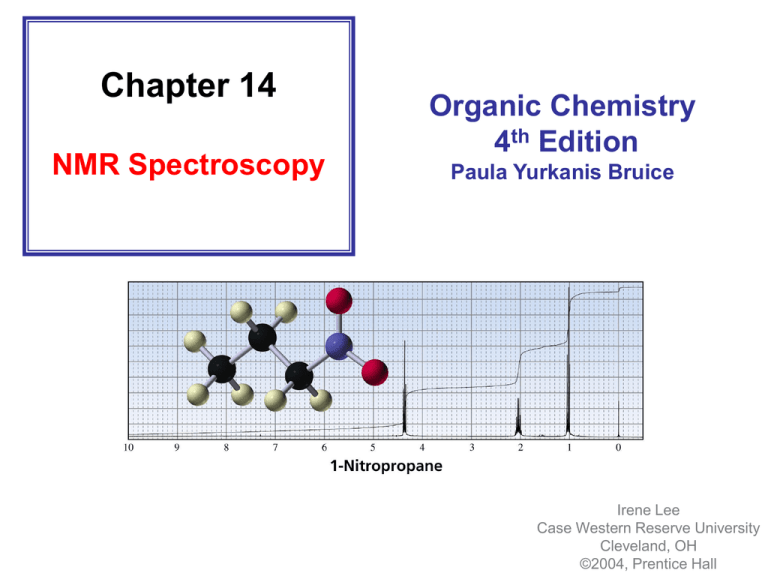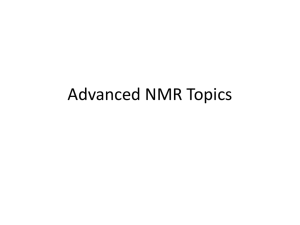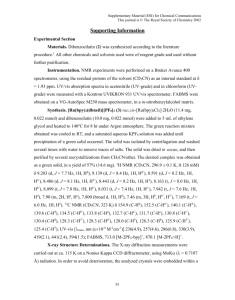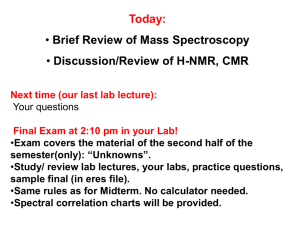Lecture Resource ()
advertisement

Chapter 14 NMR Spectroscopy Organic Chemistry 4th Edition Paula Yurkanis Bruice Irene Lee Case Western Reserve University Cleveland, OH ©2004, Prentice Hall Nuclear Magnetic Resonance (NMR) Spectroscopy Identify the carbon–hydrogen framework of an organic compound Certain nuclei such as 1H, 13C, 19F, and 31P have allowed spin states of +1/2 and –1/2; this property allows them to be studied by NMR The spin state of a nucleus is affected by an applied magnetic field The energy difference between the two spin states depends on the strength of the magnetic field absorb DE a-spin states b-spin states release DE Signals detected by NMR An NMR Spectrometer The electrons surrounding a nucleus affect the effective magnetic field sensed by the nucleus Chemically equivalent protons: protons in the same chemical environment Each set of chemically equivalent protons in a compound gives rise to a signal in an 1H NMR spectrum of that compound The Chemical Shift The reference point of an NMR spectrum is defined by the position of TMS (zero ppm) HC 3 H3C Si CH3 H3C The chemical shift is a measure of how far the signal is from the reference signal The common scale for chemical shifts = d d= distance downfield from TMS (Hz) operating frequency of the spectrometer (MHz) 1H NMR spectrum of 1-bromo-2,2-dimethylpropane The chemical shift is independent of the operating frequency of the spectrometer Electron withdrawal causes NMR signals to appear at higher frequency (at larger d values) Characteristic Values of Chemical Shifts 1H NMR spectrum of 1-bromo-2,2-dimethylpropane Integration Line The area under each signal is proportional to the number of protons that give rise to that signal The height of each integration step is proportional to the area under a specific signal The integration tells us the relative number of protons that give rise to each signal, not absolute number Diamagnetic Anisotropy The p electrons are less tightly held by the nuclei than are s electrons; they are more free to move in response to a magnetic field Causes unusual chemical shifts for hydrogen bonded to carbons that form p bonds Splitting of the Signals • An 1H NMR signal is split into N + 1 peaks, where N is the number of equivalent protons bonded to adjacent carbons • Coupled protons split each other’s signal • The number of peaks in a signal is called the multiplicity of the signal • The splitting of signals, caused by spin–spin coupling, occurs when different kinds of protons are close to one another 1H NMR Spectrum of 1,1-Dichloroethane The ways in which the magnetic fields of three protons can be aligned Splitting is observed if the protons are separated by more than three s bonds Long-range coupling occurs when the protons are separated by more than three bonds and one of the bonds is a double or a triple bond More Examples of 1H NMR Spectra The three vinylic protons are at relatively high frequency because of diamagnetic anisotropy The Difference between a Quartet and a Doublet of Doublets The signals for the Hc, Hd, and He protons overlap The signals for the Ha, Hb, and Hc protons do not overlap Coupling Constants The coupling constant (J) is the distance between two adjacent peaks of a split NMR signal in hertz Coupled protons have the same coupling constant The trans coupling constant is greater than the cis coupling constant A Splitting Diagram for a Doublet of Doublets A Splitting Diagram for a Quartet of Triplets When two different sets of protons split a signal, the multiplicity of the signal is determined by using the N + 1 rule separately for each set of the hydrogens when the coupling constants for the two sets are different When the coupling constants are similar, the N + 1 rule can be applied to both sets simultaneously The three methyl protons are chemically equivalent due to rotation about the C–C bond We see one signal for the methyl group in the 1H NMR spectrum 1H NMR spectra of cyclohexane-d11 at various temperatures axial equatorial H H H H equatorial the rate of chair–chair conversion is temperature dependent axial Protons Bonded to Oxygen and Nitrogen The greater the extent of the hydrogen bond, the greater the chemical shift These protons can undergo proton exchange They always appear as broad signals dry ethanol ethanol with acid To observe well-defined splitting patterns, the difference in the chemical shifts (in Hz) must be 10 times the coupling constant values 13C NMR Spectroscopy • The number of signals reflects the number of different kinds of carbons in a compound • The overall intensity of a 13C signal is about 6400 times less than the intensity of an 1H signal • The chemical shift ranges over 220 ppm • The reference compound is TMS Proton-Decoupled 13C NMR of 2-Butanol Proton-Coupled 13C NMR of 2-Butanol DEPT 13C NMR distinguish among CH3, CH2, and CH groups The COSY spectrum identifies protons that are coupled Cross peaks indicate pairs of protons that are coupled COSY Spectrum of 1-Nitropropane The HETCOR spectrum of 2-methyl-3-pentanone indicates coupling between protons and the carbon to which they are attached







